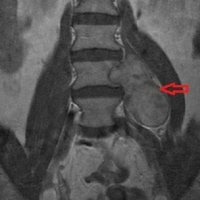Volumetric formations of the mediastinum
 This type of disease is displayed as a tumor and cyst, the causes of the disease may depend on the age of the person and the localization of formation in the middle, posterior and anterior mediastinum. Moreover, the formations can be as asymptomatic, which most often appear in adults, and cause airway obstruction, which is most common in children. At the time of diagnosis, the CT scan was started, but other studies may be performed as required.
This type of disease is displayed as a tumor and cyst, the causes of the disease may depend on the age of the person and the localization of formation in the middle, posterior and anterior mediastinum. Moreover, the formations can be as asymptomatic, which most often appear in adults, and cause airway obstruction, which is most common in children. At the time of diagnosis, the CT scan was started, but other studies may be performed as required.
What can cause voluminous formations of the mediastinum
In fact, they are divided into special groups, and in each of them there are special characteristic formations. If we consider the anterior group, it is limited to the sternum, the brachiocephalic vessels and the pericardium. The middle group includes the location between the posterior and middle mediastinum. The posterior group is confined to the trachea and pericardium, and can also be seen in the spine. As for children, frequent formations manifest themselves as a cyst or a tumor. As for adults, here it is possible to include thymoma and neutrogenic tumors. There are also lymphomas, but only at the age of 20 to 40 years.
Symptoms of formation of mediastinum
In fact, the symptoms of education should depend only on localization, and most often there are asymptomatic. Much more often accompanied by the development of clinical symptoms - malignant tumor compared with benign. Such symptoms are manifested as pain in the chest and a decrease in body weight. In childhood, symptoms are manifested when the compression of the bronchi and trachea, as well as stridor, pneumonia, recurrent bronchitis. Formation of the anterior mediastinum with large dimensions causes dyspnea in the supine position on the back. The middle mediastinum compresses the airways and blood vessels. As a result, this leads to the development of the syndrome of the genital upper vein or the obstruction of the airways. The posterior mediastinum compresses the esophagus and as a result sprouts into it. As a result, it can lead to the development of loneliness or dysphagia.
Diagnosis of mediastinum formation
In some cases, volumetric mediastinum formation may occur during chest X-ray. And also can manifest itself in other radiation studies, which are undertaken as clinical symptomatology in the chest area. Additional diagnostic studies can also be carried out, and most often biopsy and radiation, which must be carried out in order to make it easier to determine the type of education.
CT, which has intravenous contrast, is considered a more informative visualization method. Differentiate CT from other processes can be with a high degree of confidence in the chest area of normal structure in the cyst, a benign tumor. The correct diagnosis is established with various formations of the mediastinum, as a result of thick-needle biopsy and fine needle aspiration biopsy. Where aspiric fine needle biopsy is necessary for carrying out malignant processes if there is a suspicion of thymoma or lymphoma. In this process, it is necessary to make a thick-needle biopsy. If there is a suspicion of tuberculosis, then it is necessary to conduct a tuberculin test. If suspected of an ectopic tissue in the thyroid gland, a study should be made of the concentration of thyroid-stimulating hormone.
Treatment of mediastinum formation
The very same treatment will depend on the type of volumetric education, there are special benign formations, the cicada of the pericadra, which can also be observed. Many malignant tumors must be removed only surgically, but in special cases it is necessary to conduct chemotherapy. When manifesting granulomatous diseases, mandatory antimicrobial therapy is necessary.
Indications for surgical treatment
It is mandatory to perform surgical intervention in the manifestation of neoplasms mediastinum. Such diseases as sarcoma, carcinoid tumors and invasive thymus will not be doubted. But at the same time, exceptions are noted, these are mediastinal lymphomas, and for such treatment it is necessary to use chemoradiation therapy. Let's consider the indications for surgical treatment, it can be determined by such circumstances.
First of all, it can be noted that any formation can manifest itself in a malignant form. And if you use conservative tactics in the absence of morphological reliable confirmation, this leads to the invasion of vital structures and organs. For such a case, the study of the surgical preparation is best used. The remaining methods will not bring full confidence.
Every benign or malignant three-dimensional process that is displayed in a confined space entails a potential threat. If you base on all the recommendations given on the indication for surgical treatment, the following items can be assigned. Any form of mediastinum histological diagnosis could not plausibly clarify the morphological diagnostic method. Malignant tumors with distant metastases are complicated by mediastinal compression, as well as any locally distributed and local formations, with the exception of mediastinal lymphomas.
If we consider that asymptomatic cysts or other benign formations will be absolutely harmless, they are related to non-operative treatment. In this case, it is impossible to give consent from a conservative point of view, since a benign tumor and cyst are not as dangerous if viewed in the ratio of organ compression syndrome compared to malignant neoplasms. In the medical literature there is a lot of information about the different variants of the mediastinal compression syndrome, which are caused by benign pathology.
Contraindications to surgical treatment of
Given that each volumetric formation is associated with a risk of dangerous complications for the life of the patient, it is best to note not only the contraindications to surgical treatment, but also the principles of choosing the method of surgical aggression. Using modern surgical techniques, it is possible to intervene in different volumes, reconstruct and resect on many anatomical structures.
To syndrome of mediastinal compression in different clinical variants it is possible to attribute not only a contraindication, but also a vital indication in the field of surgical intervention. Cavity wide interventions in the mediastinal education will be contraindicated if there is pronounced coronary, respiratory, renal, hepatic, cerebral insufficiency. Only if they are not related to the formation of the mediastinum. If this happens, then the question will need to be addressed individually.



